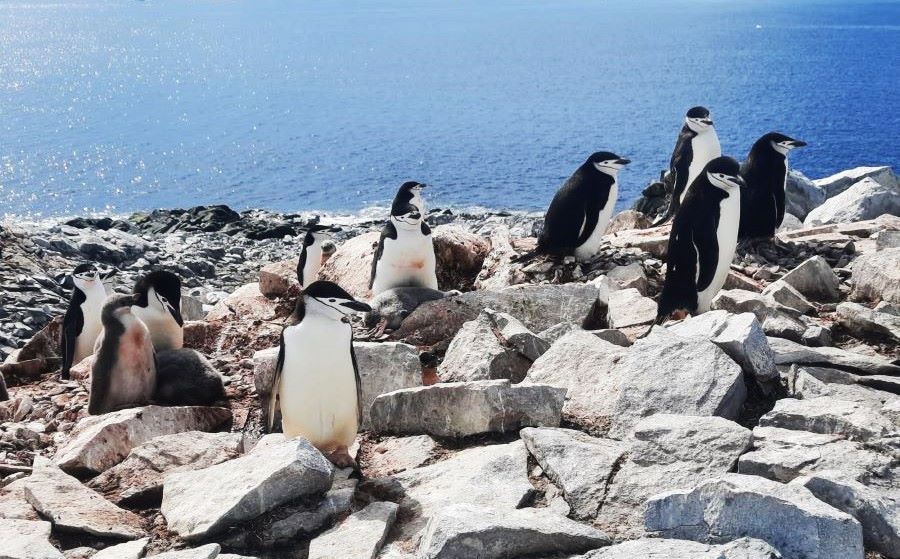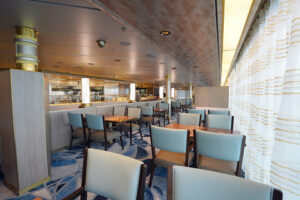It’s one thing to go on an expedition cruise. It’s yet another to qualify as a true explorer. But guests and Viking‘s expedition team sailing on one Viking Octantis Antarctica voyage in January 2024 certainly did both. They helped discover a new colony of chinstrap Antarctica penguins not previously known to science!
That occurred on the white continent’s Diaz Rock, near Astrolabe Island. At the time, Viking’s expedition vessel was visiting that three-mile-long island in the Bransfield Strait along the Trinity Peninsula.
While Astrolabe Island is already home to a colony of chinstrap penguins, that colony hadn’t been scientifically surveyed since 1987. So, during the Viking Octantis’ visit, Viking’s scientific partner, Oceanites, a field research entity specializing in Antarctic penguin monitoring, conducted the first visual and thermal aerial survey in almost 40 years.
(Shown above are chinstrap penguins in Antarctica. Photo by Dr. Grant Humphries.)
Antarctica Penguins: Newly Discovered Colony
And then it happened! Presto, in that process, the survey discovered the separate, previously unknown colony on Diaz Rock. Thus, guests seeing these penguins weren’t simply Antarctica tourists.
Instead, they truly envisioned themselves as polar explorers akin to Amundsen, Shackleton and Scott!
“It is not often we find a new penguin colony,” acknowledges Dr. Grant Humphries, director of science at Oceanites, speaking about the recent discovery at Diaz Rock. “This work will allow us to get a better understanding of how Antarctica’s penguin population dynamics are shifting in an ever-changing world.”
Viking believes that every expedition voyage should provide opportunities for meaningful scientific discovery. “With our third season in Antarctica underway, we are pleased to have supported another significant scientific development that will allow for further understanding of the region,” says Torstein Hagen, Viking’s chairman.
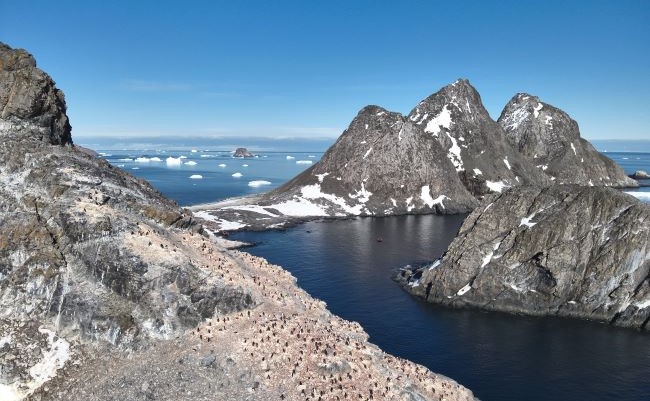
Up Close to Wildlife
Certainly, Antarctica penguins are a big draw for eco-minded guests eager to see wildlife up close. Many travelers are looking to visit Antarctica in 2024 or beyond via the 378-passenger Viking Octantis or identical sister Viking Polaris.
Viking’s Antarctic voyages of exploration and discovery are offered November through February. What’s the big draw? Travelers will gaze at dramatic, ice-and-snow scenery, multiple species of penguins, many birds, and whales and other marine life.
In addition, while accompanied by members of the ship’s 36-person expedition team, expedition cruise guests will head out on Zodiac rides, beach walks and hikes.
That said, Viking’s two expedition ships also offer more indoor and outdoor viewing areas than most expedition vessels. So, guests don’t even have to leave the ship for stellar views.
Antarctica Penguins: Cute Black-and-White Waddlers
It’s a fact. Travelers absolutely love seeing and taking selfies with penguins of multiple species in Antarctica. At times, these cute black-and-white birds are spotted waddling up a hillside on a penguin trail.
Travelers — per Antarctica’s strict wildlife regulations — must step out of the way to allow penguins “first dibs” on that trail. At other times, guests taking a Zodiac ride might view the cute, black-and-white fuzzy birds resting on an iceberg.
There’s no touching the cute penguins, though. Regulations require viewing them in a quiet, respectful manner. Of course, selfies are permitted at a bit of a distance.
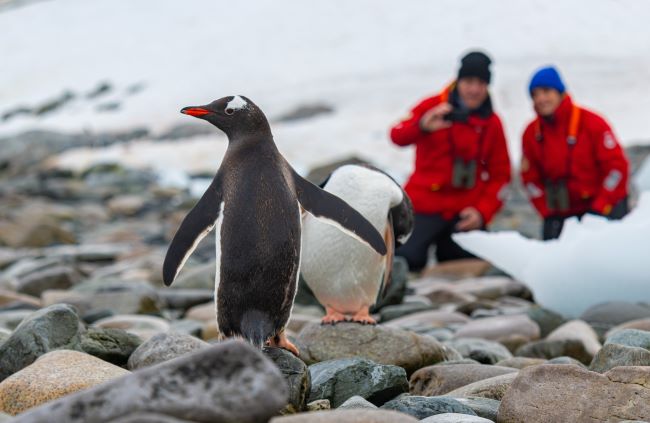
Personally, when The Meandering Traveler visited Antarctica on a late 2022 expedition cruise, we most loved watching chinstrap penguins in the ocean. As accomplished swimmers, they’re speed demons at up to 18 mph in the water.
Suddenly, they leap from the water, soar for a second or so and then quickly hit the water again. On land, though, think of them as tobogganers. They lie on their stomachs and push themselves along on the icy terrain with their flippers.
More Factoids about Antarctica Penguins
Here are a few other fun factoids about chinstrap penguins. First, their colonies can be very large. In fact, some contain more than 100,000 pairs of adults.
Size-wise, they’re about 25 inches to 30 inches tall, and they weigh up to 11 pounds. They sport a black back, flippers, bill and cap on their head, plus a black strap that runs under their chin.
When they get the munchies, chinstraps love going into the water. The quest is for seafood — fish, shrimp, squid and krill. But the penguins themselves have to be watchful. Orcas and leopard seals consider them tasty prey.
Generally, chinstrap penguins are monogamous, returning to the same mate every year. And they can live 20 years or so.
Most notably, they’re also called “stonebreaker penguins.” No, they don’t collect stones for their nests.
Instead, they simply have a big mouth! Their screeching is so loud and piercing that people say it’s enough to break stones.
Viking’s “Antarctica Explorer” Itinerary
So, how can you too be an explorer, see thousands of penguins of all types and explore the farthest reaches of Earth? “An expedition cruise is the ticket,” emphasizes Shelby Steudle, president, Pavlus Travel.
“In late 2024 as well as January, February, November and December of 2025 and 2026, Viking sets sail with an incredible, 13-day “Antarctica Explorer” itinerary,” she adds. “And timing is flexible as a sizable number of departure dates are offered throughout each winter season.”
The “Antarctica Explorer” itinerary begins in Buenos Aires, Argentina, and then guests take a flight to Ushuaia at the end of southern Patagonia. There, guests embark their Viking expedition ship.
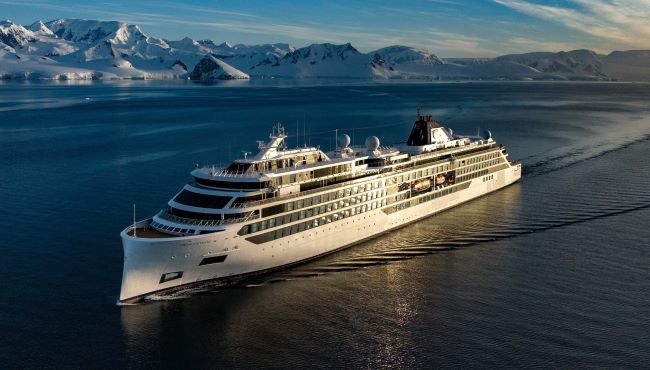
Sailing southward, the ship spends a day at sea crossing the Drake Passage. Once in Antarctica, guests are blessed with seven full days of exploration time. Then, the ship begins its journey back to Ushuaia across the Drake Passage.
A bonus? The ship also offers guests a day of scenic sailing in the Cape Horn area.
At press time, fares began at $11, 995 per person, double occupancy. But talk to your personal travel advisor about any unadvertised discounts, promotions or incentives.
Viking Expedition Team and Scientific Partners
During each Viking expedition, visiting researchers from partner institutions are part of the ship’s multidisciplinary expedition team. They lead guests through scientific research, guide shore trips, provide lectures and more.
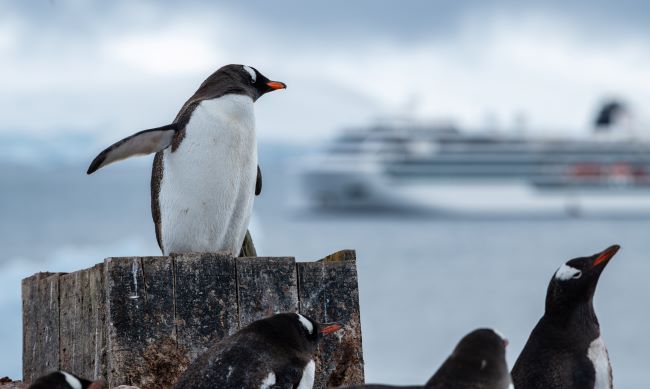
In addition to Oceanites, Viking partners with many other scientific groups aboard its two expedition vessels. That facilitates helpful polar research and also guarantees a unique, authentic Antarctica experience for guests.
Those partners range from the University of Cambridge’s Scott Polar Research Institute (SPRI) to the Cornell Lab of Ornithology and the Norwegian Polar Institute, among others.
For more information on Viking’s polar itinerary options, visit the line’s Antarctica website page. For questions about a potential Antarctica cruise and to discuss accommodations or itineraries, call your personal travel planner today.
After all, the penguins await!
Important Notes from Pavlus Travel
- For information about the best deals, sign up for Pavlus’ email newsletter, which spotlights terrific pricing on a multitude of cruise and travel options. Readers can simply add their email to the sign-up box on the top right corner of the Pavlus Travel website.
- If anything tweaks your interest in this blog above, and you DO have questions about specific pricing, brochures, savings, accommodations, accessible options and so on, please contact us at 800-528-9300.
- Or visit us online at Pavlus Travel’s official agency Web site; there you can “live chat” with us online too!
- This blog site provides “basic, general information” about travel. It’s not staffed by travel advisors.
- Any price examples and included vacation features in blogs are subject to change. They also don’t represent the full range of options; a travel advisor can assist with additional information.
- Please don’t use the Reply Section below if you are asking for pricing, travel dates, accommodations, brochures or other specific requests. Please use the 800 number or online link.
